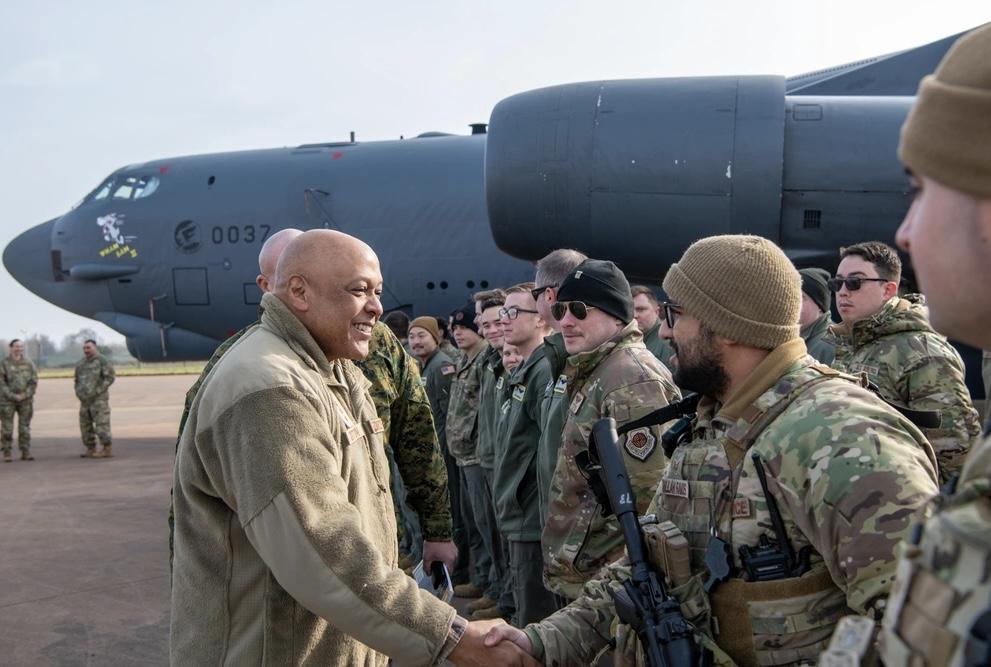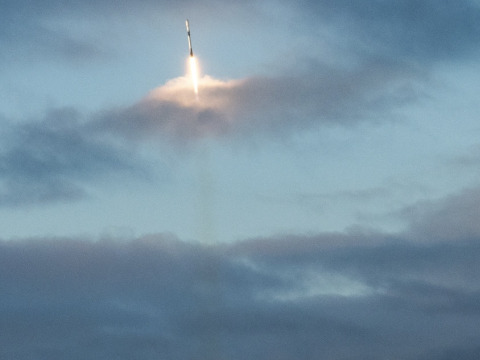Nebraska Experts Work the Spectrum
The U.S. Department of Defense (DOD) has some “big challenges” when it comes to spectrum operations, with the environment becoming more and more congested. The National Strategic Research Institute (NSRI) assists the U.S. Strategic Command (USSTRATCOM) in crucial research for future operational spectrum capability and tactics, said Allan Geist, director of the NSRI’s Electromagnetic Spectrum Operations Program, Strategic Deterrence and Nuclear Program Division.
“The spectrum is more pivotal in competition and conflict than it ever has been before,” he stressed. “And the DOD has been very clear that they want to work with the commercial side of what companies are doing with the spectrum. They don’t necessarily want to carve out pieces of it for themselves. They want to work with the Federal Communications Commission and the Commerce Department to find solutions so that we can all work in the spectrum.”
The NSRI is a Department of Defense-designated University Affiliated Research Center or UARC, sponsored by USSTRATCOM. The NSRI is supported by the University of Nebraska system, including the campuses at Omaha, Lincoln, Kearney and the University of Nebraska Medical Center.
Geist, a retired Air Force colonel, B-1 pilot and Navy Top Gun exchange pilot, specialized in electronic warfare and was the commander of the 390th Electronic Combat Squadron at Naval Air Station Whidbey Island, Washington.
Of the 15 UARCs in the DOD, the NSRI is unique, Geist said. “What makes us different is that we are the only one sponsored by a combatant command,” he explained. “All of the other UARCs are either sponsored by the Office of the Secretary of Defense or a service. This gives us a different flavor or a different viewpoint of supporting a combat command demand versus services.”
In July 2024, USSTRATCOM stood up the Joint Electromagnetic Spectrum Operations Center—run by Maj. Gen. AnnMarie Anthony, USAF—which the NSRI is now supporting.
The center ensures that the joint force—comprising all the services and other combat commands—can fight in a contested, denied environment, with electromagnetic-related warfare. It looks at how the services and commands present their forces in ways that support electromagnetic spectrum operations.
“[They are seeing] how the services have thought through how they are going to handle the spectrum, how they are going to fight through certain things, how they are going to manage it,” Geist stated.
One of the solutions the NSRI is charged with researching is dynamic spectrum sharing. With Nellis Air Force Base, Nevada, the institute is working first to characterize the spectrum, harnessing artificial intelligence (AI) and machine learning (ML) to identify signals in congested space.
“We are doing that with deep neural networks and large language models,” the director stated. “That is one piece of it, and how we more efficiently and quickly pick up the signals in the environment that we need to move around, and how we are trying to move into the right spot.” Then, the frequencies need to be optimized, either by “putting them in the right time slot, or the right geography, if you will. Because even that is a big piece, and then pick out the right time frequency-sharing capabilities for that.”
In addition, as part of the tactics, techniques and procedures (TTPs) of dynamic spectrum operations, the NRSI is also examining possible TTP solutions, Geist continued. “From just a TTP standpoint, how do we move around the spectrum manually, if you will, to how do we do the dynamic spectrum piece,” he said. “A lot of that is a time-sharing basis, but there is a lot of optimization that has to go into that.”
And the main thing artificial intelligence and machine learning offer is not only optimization, but time. “It is very cumbersome to do that manually,” Geist continued. “And if we can get AI/ML to help us do that, it is going to be a key piece of what the department is looking at.”
For this effort, the NSRI is relying on its partners at the University of Nebraska-Lincoln, where researchers, led by research fellow Can Vuran, are using an emerging deep neural network technology called complex-valued neural networks, or CVNNs.
Vuran is the Dale M. Jensen chair professor of computing at the School of Computing at the University of Nebraska-Lincoln and specializes in research on wireless communications and sensing systems. He also directs the university’s Cyber Physical Networking Laboratory.
“These [CVNNs] are new kinds of AI solutions that have not seen mainstream adoption yet,” Vuran said. “They are very much research grade, and we are applying these technologies and then further tailoring them for wireless communication.”
The researchers are leveraging the machine learning solution to detect signals from a wide-band frequency sample, which may include multiple signals. The signals are unknown, as are their spectrum frequencies and bandwidths.
“And our goal is to detect these signals even at what we call a low SNR [signal-to-noise] ratio, which is low quality,” Vuran said. “Basically, they are hidden in the spectrum, and we detect the signals first and then identify their features, such as where they are located in the spectrum and their bandwidth, because those features can provide more information about whether they are standard compliance signals. Are they signals that we are expecting to be there, or maybe they are adversarial signals.”
The early results show the AI-CVNN capability improving signal detection.
“We are seeing accuracy at about 95%-98%, even with low SNR, low-signal strength levels,” Vuran shared.
In addition, the CVNNs are “very fast” in terms of the model’s training, which has positive resource implications, given the energy requirements of AI/ML and costs. “Having algorithms that are more efficient and also more accurate is important,” he noted.
Geist suggests that this kind of dynamic solution could also be shared with the commercial sector. “If we can share that technology, those efforts or that research, that will help them as well—it will help everybody,” he said. “Artificial intelligence and machine learning is not this panacea of capability that everyone thinks that it is, but I think we are making strides in that dynamic spectrum-sharing piece, digging out those signals.”
It is an important solution for the future, since not only is the spectrum becoming more complicated and congested, but the systems that use it are more complex than ever before.
“There are systems out there that can change their frequency, their polarization,” Geist emphasized. “It makes it very hard, because in the past, we would just use a library of signals the intelligence community would give to the DOD. Our receivers and processors would then receive a signal, we’d take it in and compare it to the library. Now, these signals have become so dynamic and up and down the spectrum that that just doesn’t work anymore. And then, the other piece is the cognitive electronic warfare piece, and without going into too much detail, that is a much more complex problem.”

We were charged with going out and figuring out what does aerospace electronic attack look like in the future, and what should DOD be focusing on.
The University of Nebraska-Lincoln’s foray into dynamic spectrum-sharing research—including for the NSRI—began two decades ago and extends from Vuran’s doctoral research at the Georgia Institute of Technology. “We published seminal work on cognitive radio networks and dynamic spectrum-sharing solutions,” he explained. “Back then, it was more of a future-looking position paper, laying out the challenges. Now we are reaching a point where the spectrum is extremely limited. We are in the ‘spectrum crunch,’ where the demand is not being able to be supplied through the way we utilize spectrum.”
The Nebraska university is also working with the Naval Surface Warfare Center Crane, Indiana, to examine AI-driven spectrum sensing solutions.
Additionally, the university researchers are in the first year of a three-year grant project with USSTRATCOM and the NRSI, where they are using software-designed radios and are designing tailor-made radio frequency, spectrum-related AI solutions, as well as using existing algorithms.
“We are supported by STRATCOM and NSRI for research on AI-based transceiver architectures, radio architectures that can transmit and receive, where AI is the is the core component of the architecture,” Vuran noted. “We are trying to leverage several AI frameworks, including some of the mainstream ones, like large language models or reinforcement learning, and our innovations as well, to design transceivers that will ... essentially utilize the spectrum in a more efficient way.”
Given the national security implications, Vuran couldn’t go into more detail, except to note that it was about seeing if they could adapt the dynamic electromagnetic spectrum operations to the environment itself, and making the radios more agile.
Naturally, existing AI solutions with image, video or text natural language processing have to be adapted for wireless communications. “At a foundational level, they are not built for wireless solutions,” Van Duran emphasized. “They are completely different.”
Meanwhile, the NSRI is also examining adaptive waveforms and how to dynamically change them to allow for simultaneous transmission of a signal in a congested environment. “That is a big piece, and very exciting research that we are doing,” Geist said.
For this area, the NSRI is performing fundamental development at the 6-1 Basic Research level and proving out concepts for adaptive waveform generation. The researchers consistently check in with USSTRATCOM to see how they would like to advance adaptive waveforms. “We work hand-in-hand with STRATCOM to make sure we distill those problem sets down so that we can execute the right research for them and give them a piece of the puzzle, if nothing less, to solve their problems.”
In addition, the NSRI is helping to draft a joint concept for aerospace electronic attack from an operations perspective.
“We were charged with going out and figuring out what does aerospace electronic attack look like in the future, and what should DOD be focusing on,” Geist explained. “Basically, we are giving some guide rails to how they should operate in the spectrum as well as what would enable those operations from a hardware, training and education standpoint.”
The institute performs operational risk analysis to address adversarial capabilities, leveraging work from the Joint Information Operations Warfare Center at Lackland Air Force Base in San Antonio. With 24-7 operations, that center has a clear view of risk analysis for electronic warfare. The NSRI extrapolates operational risk analysis into the future to come up with a systems engineering approach to lay out the future of aerospace electronic attack, the director explained.
Another “very preliminary” area that the NSRI is considering is electronic battle management for joint warfighting. The DOD does not have a cohesive, holistic approach to electromagnetic spectrum operations across the department, and it should, Geist advised.
“Electromagnetic spectrum operations touch everything—the spectrum is being used by everything and everyone,” he said. “How do you put up types of guardrails? Inside a portfolio, how do you track everything, and make sure that we are buying the right things and make sure that we are fighting with the right things. This joint ops concept that NSRI is doing will help with some of that.”
Looking at the problem set from a joint perspective, the service level will help examine how to train, educate, procure systems, fight and maneuver in the spectrum, he said.

Our goal is to detect these signals even at what we call a low SNR [signal-to-noise] ratio, which is low quality.




Comments